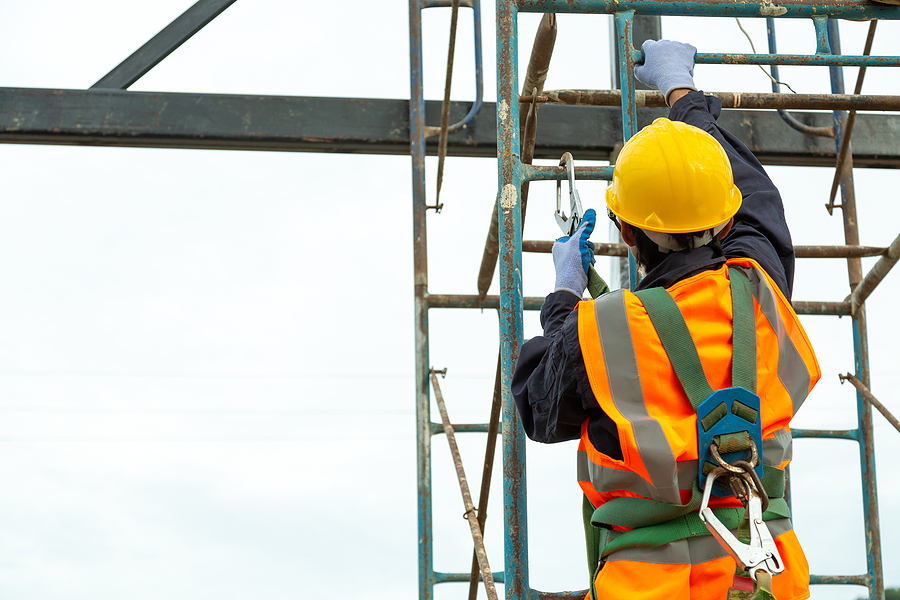New Mexico Construction Company Fall Protection is Critical – Here Is Why

The term “fall protection” refers to a collection of techniques and devices installed in a work environment to reduce the risk of accidents caused by falls. With falls being a leading cause of industrial injuries and fatalities, fall prevention is critical for ensuring worker safety in industries as diverse as construction and shipbuilding. Before letting employees onto a New Mexico construction site, construction companies must install fall protection systems.
Learning the fundamentals of fall protection and why it’s so crucial helps prevent injuries and ensure your workers always go home safely. To ensure the well-being of your workforce and avoid potential fines from the Occupational Safety and Health Administration (OSHA), familiarize yourself with its regulations.
Why Fall Arrest Systems Are Necessary
In 2019, roughly 38% of construction-related fatalities were caused by falls. There are often several contributing factors to a fall, but most falls can be avoided with the right precautions and gear. Implementing fall prevention measures helps lessen the likelihood of people falling and becoming hurt on the job.
The safety of your employees should be your primary priority as an employer, and you should emphasize the significance of fall protection to your staff. Lifesaving is one of the most important advantages of fall protection. The use of fall prevention devices helps prevent workers from suffering life-threatening injuries due to accidental falls.
Ways to Reduce Waterfalls
Thankfully, there are a variety of things you can do to assist reduce the risk of injuries due to falls at work. Before beginning any work, it is vital to consider the possibility of falls. Consider all potential ways an employee could fall and consider strategies to prevent them. Foreseeing potential hazards allows appropriate fall protection to be implemented before any accidents occur. The term “hazard assessment” is commonly used to describe this procedure.
Make a plan for fall protection based on what fall protection systems are required after evaluating the work site. You must ensure that your employees have access to adequate fall protection. To find out if any of the following fall prevention solutions are suitable for your business, have a look:
- Workers on higher platforms should have guardrail devices constructed to keep them from falling to the lower platform below.
- Workplaces with personnel hung at great heights or over machines typically have safety net systems installed beneath them. Under bridges and skywalks, for instance, safety nets would be a good idea.
- Personal fall protection systems, also known as personal fall arrest systems, can be used to prevent employees from falling from heights. These methods are utilized to keep the employee rooted in their current position.
- When exposed sides or edges of a roof are exposed, warning lines are utilized to draw attention to them. Putting up warning lines helps alert workers to potential dangers to take precautions.
- Zones of restricted access are places where certain tasks are being performed without standard fall protection. To avoid having too many people in potentially dangerous regions, access is usually restricted to those who need to be there.
- Together, these fall protection measures, safe work practices, and extensive training can significantly reduce workplace falls. Even if you install the appropriate fall protection systems, your employees will still be at risk if they aren’t given the right training to use them.
What to Do If You Have a Fall
You and your coworkers must know what to do if one of your colleagues is hurt from a fall. In some situations, how to provide CPR and first aid is the difference between life and death. What you do next depends varies on the kind and extent of the person’s injuries, but here are some things to think about in any such situation:
- In an emergency, the first thing you should do is dial 911. In serious injuries requiring medical attention, this must be done immediately.
- It’s recommended not to move the fallen person about too much. Additionally, it is important to prevent them from standing up or moving around, as doing so may exacerbate any inside injuries.
- Administer first aid and CPR; if the victim is bleeding, gently apply pressure to the wounds to staunch the blood flow. Verify if the person is alert and breathing and if their pulse is steady. Without a heartbeat, you should start CPR and keep it going until help arrives.
Although these situations might be tense and hectic, everyone involved must remain cool. Keeping your cool will allow you to provide better aid to the hurt party. In addition, make sure the injured worker stays calm, and that aid is on the way.
Create the appropriate paperwork: Potentially, your firm has its system for reporting incidents. Likewise, make sure you inform OSHA of any fatalities or significant injuries.
Preventing Employee Falls: Mandates for Employers
Employers are obligated under OSHA law to offer personal fall arrest systems to their workers so that they may avoid injury in the event of a fall from height. To comply with OSHA regulations, businesses must keep in mind the following:
Checking for potential dangers: OSHA mandates a risk assessment of the workplace. The duty of deciding whether to provide fall protection rests with the employer, who must assess the site in question. If this is the case, employers are responsible for deciding on and providing workers with their preferred means of fall protection.
Varying height restrictions: OSHA specifies minimum heights for specific operations for which employers are responsible for providing fall protection. Longshoring jobs require fall protection at heights of 8 feet, construction at 6 feet, the shipyard at 5 feet, and general industrial tasks at 4 feet. If employees operate above potentially hazardous gear and equipment, such as conveyor belts, you must offer fall protection regardless of the height difference.
Businesses must maintain clean, dry workplaces to avoid accidents with employees falling due to wet floors or other risks.
Staff education: Workers of all levels need accurate, accessible education on workplace dangers and fall precautions in languages they can comprehend.
Adequate training is a crucial component of preparing workers for potentially dangerous conditions on the job. Numerous options exist for imparting knowledge to staff members.
